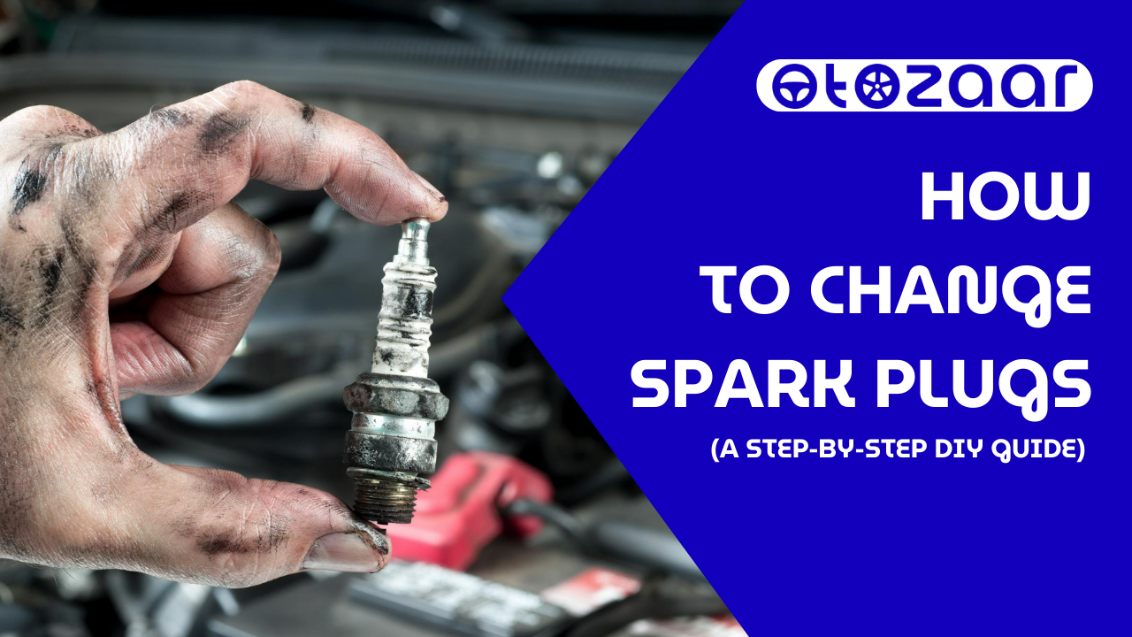Changing spark plugs is an important part of car maintenance that you can do yourself with some basic tools and knowledge. This guide will walk you through the process of how to change spark plugs in your vehicle, tailored for drivers in the United Arab Emirates (UAE). By learning how to change spark plugs yourself, you can save money on maintenance and keep your car running smoothly in the UAE’s hot climate.
Why Change Spark Plugs?
Before we dive into the steps to change spark plugs, let’s understand why it’s important:
- Improved Fuel Efficiency: Fresh spark plugs help your engine burn fuel more effectively, which can lead to better mileage.
- Better Engine Performance: Worn-out spark plugs can cause misfires, leading to a rough engine performance. New plugs ensure smooth operation.
- Smoother Engine Running: Regularly changing your spark plugs allows your engine to run more smoothly, providing a better driving experience.
- Reduced Emissions: Good spark plugs can help reduce harmful emissions from your vehicle, contributing to a cleaner environment.
- Prevention of Engine Misfires: By changing spark plugs regularly, you can prevent engine misfires, which can lead to costly repairs if left unchecked.
In the UAE’s hot climate, regular spark plug maintenance is especially important to keep your car running well.
Tools Needed to Change Spark Plugs
To change spark plugs, you’ll need the following tools:
- New Spark Plugs: Make sure they’re the right type for your car. Check your car manual for specifications.
- Spark Plug Socket: Usually 5/8″ or 13/16″, this is designed to fit over the spark plugs.
- Ratchet Wrench: This helps you loosen and tighten the spark plugs easily.
- Extension Bar for the Ratchet: This is useful for reaching spark plugs that are hard to access.
- Gap Tool: If your new plugs aren’t pre-gapped, you’ll need this tool to measure and adjust the gap between the electrodes.
- Torque Wrench: This ensures that you tighten the spark plugs to the manufacturer’s specified torque.
- Anti-Seize Compound: Optional, but recommended to prevent the spark plugs from seizing in the cylinder head.
- Dielectric Grease: This helps protect the spark plug connections from corrosion.
Preparing to Change Spark Plugs
Before you start, take these preparatory steps:
- Ensure Your Car Engine is Cool: Never work on a hot engine to avoid burns or injuries.
- Park Your Car on a Flat, Stable Surface: This will help prevent accidents while you work.
- Engage the Parking Brake: This ensures your vehicle stays stationary while you’re working on it.
- Disconnect the Negative Terminal of the Battery for Safety: This prevents any electrical shorts while you work.
Step-by-Step Guide to Change Spark Plugs
Step 1: Locate the Spark Plugs
To change spark plugs, you first need to find them. In most cars, they’re located at the top of the engine, connected to thick rubbery wires. In some cars, you might need to remove an engine cover to access them. Take a moment to familiarize yourself with their location.
Step 2: Clean the Area
Before you change spark plugs, clean the area around them. Use compressed air or a brush to remove any dirt or debris. This prevents contaminants from falling into the engine when you remove the old plugs. Keeping the area clean is vital for the longevity of your engine.
Step 3: Remove the Spark Plug Wires or Coil Packs
Depending on your car, you’ll either have spark plug wires or coil packs. To change spark plugs, you need to remove these first:
- For Wires: Gently pull on the boot at the end of the wire. Never pull on the wire itself, as this can cause damage.
- For Coil Packs: These are usually held in place by a bolt or two. Remove the bolts and gently pull the coil pack out. Be careful not to break any connectors.
Step 4: Remove the Old Spark Plugs
Now you’re ready to change spark plugs. Here’s how:
- Attach the spark plug socket to your ratchet and extension.
- Place it over the spark plug and turn counterclockwise to loosen.
- Once loose, remove the plug by hand to avoid dropping it into the engine. Ensure you’re gentle and steady to prevent any damage.
Step 5: Check the Old Spark Plugs
Before you change spark plugs with new ones, examine the old ones. They can tell you a lot about your engine’s health:
- Tan or Gray Plugs: These are normal and indicate the engine is running well.
- Black, Sooty Plugs: This might indicate a rich fuel mixture, meaning too much fuel is reaching the engine.
- White, Chalky Plugs: These could mean the engine is running too hot, which is concerning and needs attention.
Step 6: Gap the New Spark Plugs
If your new plugs aren’t pre-gapped, you’ll need to gap them before you change spark plugs:
- Check Your Car Manual for the Correct Gap Size: The recommended gap size will vary based on your vehicle.
- Use the Gap Tool: Measure and adjust the gap between the center and side electrodes to meet the manufacturer’s specifications. This is crucial for optimal performance.
Step 7: Install the New Spark Plugs
Now it’s time to change spark plugs with the new ones:
- Apply a small amount of anti-seize compound to the threads (if recommended by your car manufacturer). This helps in future removals.
- Carefully thread the new plug in by hand to avoid cross-threading. Be gentle and make sure it’s going in straight.
- Once hand-tight, use the torque wrench to tighten to the specified torque in your car manual. Proper torque is crucial for the longevity of the spark plugs.
Step 8: Reconnect the Wires or Coil Packs
After you change spark plugs, reconnect the wires or coil packs:
- Apply a small amount of dielectric grease inside the boot. This helps prevent moisture from entering and causing corrosion.
- Push the boot firmly onto the new spark plug until you hear a click, indicating it’s securely in place.
- For coil packs, reinsert them and secure the bolts. Ensure everything is tight and secure.
Step 9: Finishing Up
To complete the process to change spark plugs:
- Replace any engine covers you removed, ensuring all clips and bolts are secured.
- Reconnect the battery’s negative terminal. Make sure the connection is tight to prevent any electrical issues.
- Start the engine to ensure it’s running smoothly. Listen for any unusual sounds or vibrations.
Tips for Changing Spark Plugs in the UAE
When you change spark plugs in the UAE, keep these tips in mind:
- Work During Cooler Hours: The UAE can get very hot, so try to work on your car in the early morning or evening when temperatures are lower.
- Stay Hydrated: Keep water nearby, as working on your car can be thirsty work in the UAE climate. Dehydration can sneak up on you, so drink plenty of fluids.
- Use the Right Spark Plugs: The hot climate in the UAE might require specific types of spark plugs. Consult your car manual or a local mechanic for advice.
- Regular Checks: Due to the heat, it’s a good idea to check your spark plugs more frequently than you might in cooler climates. Regular maintenance can help prevent unexpected breakdowns.
- Be Careful of Dust: The UAE’s sandy environment means you need to be extra cautious about keeping sand out of your engine when you change spark plugs. Use a clean cloth to cover the area when you’re working.
When to Seek Professional Help to Change Spark Plugs
While changing spark plugs is a task many can do at home, there are times when it’s best to seek professional help:
- If You’re Not Comfortable Working on Your Car: If you have any doubts, it’s better to consult a professional.
- If You Can’t Reach the Spark Plugs Easily: Some cars have spark plugs in hard-to-reach places. Don’t risk damaging your engine; let a professional handle it.
- If You Notice Unusual Wear or Damage on the Old Plugs: If the old plugs look burnt or damaged, a professional can assess the issue more effectively.
- If Your Car Doesn’t Run Smoothly After You Change Spark Plugs: If there are still issues after changing them, it’s best to have a mechanic take a look.
Many garages in the UAE offer spark plug replacement services if you’re not comfortable doing it yourself.
Conclusion: Mastering the Spark Plug Change
Learning how to change spark plugs is a valuable skill for any car owner in the UAE. It can save you money and help you understand your car better. By following this guide and practicing, you’ll soon be able to change spark plugs with confidence.
Regular maintenance, like changing spark plugs, can help your car cope better with the UAE’s hot climate and sandy conditions. It keeps your engine running efficiently, which is especially important given the long distances many people drive in the UAE.
Whether you choose to change spark plugs yourself or have a professional do it, make sure it’s part of your regular car maintenance routine. Your car (and your wallet) will thank you for it! Happy driving, and stay safe on the roads!





